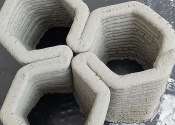Concrete is a construction material composed of cement (commonly Portland cement) as well as other cementitious materials such as fly ash and slag cement, aggregate (generally a coarse aggregate such as gravel, limestone, or granite, plus a fine aggregate such as sand), water, and chemical admixtures. The word concrete comes from the Latin word "concretus" (meaning compact or condensed), the past participle of "concresco", from "com-" (together) and "cresco" (to grow).
Concrete solidifies and hardens after mixing with water and placement due to a chemical process known as hydration. The water reacts with the cement, which bonds the other components together, eventually creating a stone-like material. Concrete is used to make pavements, architectural structures, foundations, motorways/roads, bridges/overpasses, parking structures, brick/block walls and footings for gates, fences and poles.
Concrete is used more than any other man-made material in the world. As of 2006, about 7.5 cubic kilometres of concrete are made each year—more than one cubic metre for every person on Earth. Concrete powers a US $35-billion industry which employs more than two million workers in the United States alone.[citation needed] More than 55,000 miles (89,000 km) of highways in the United States are paved with this material. Reinforced concrete and prestressed concrete are the most widely used modern kinds of concrete functional extensions.









